
BEANS RAISED BED: A POTENTIAL NEST SITE FOR AN ANTS COLONY?
(Blackish-red Ants, Length Approx. 2 - 4 mm)
September 01, 2021
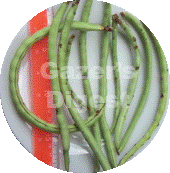
The plants on the bed are somewhat similar to the long bean vines. Branches come out of the main plant stem, and the longest length from the base to a leaf can extend by 11-foot or more.
The flowers are white. Plants can have about twenty seeds in a pod. The plant's pods, which look like cowpea pods, are light green, cylindrical, tender, and about 18 cm long. They can be consumed as a vegetable.
ANTS WERE BUSY
There were four plants on the raised bed. One day, I observed that one of the pods that touched the bed had few openings, with a bunch of ants at one end and some ants could be seen moving over the pod.
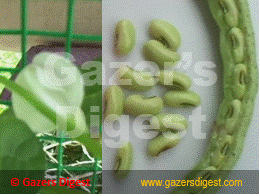
Other pods looked as if there was nothing wrong with them. It was not clear whether the ants could feed on the pods.
The ants were increasing in number and spreading rapidly. A few days later, the ants had reached almost all the pods, including younger pods, on the bed. The ants had damaged several pods. Also, I noticed there were some openings on the main stems and branches too.
Ants were very active during the day and the night. One plant was losing its leaves. Another plant's leaves had started to turn yellow. There were signs that these ants were forming a colony in the raised bed.
APPEARANCE

Some ants are different than others—a few big blackish-red ants are among a large number of small ants.
The big ants are about 4 mm in length and the other small ants are about 2 mm long.
WHAT'S WRONG WITH THE BED?
The bed hadn’t received much sunlight. Exposed to several days of heavy rainfall, topsoil was no longer remained dry. Plants’ debris and some weeds were there.
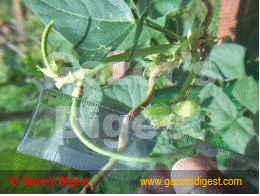
The leaves had created shady areas around the plant bases. I observed ants on several branches, at the bases of all the plants, and the base of a decaying wooden pole, which was used to support the plants.
TROUBLESHOOTING
I removed all the damaged pods as some ants were seen on the damaged pods.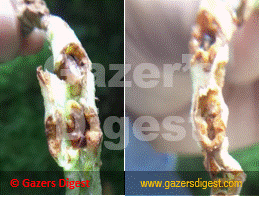
Several bunches of ants were busy working on fresh beans as well. I tapped the pods, so that the ants fell on the bed, and then covered all the beans, to make it difficult for ants to damage the fresh ones. I also continue to clear the bed--removed plant debris and weeds.
Rainy weather was over, the bed started to receive enough sunlight again. On a sunny day, around noon, I inspected the bed and I noticed that there was a significant reduction in ants.
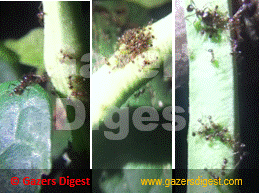
However, I saw that some ants still gathered around the plant bases. So, I cleared debris and weeds to make the plant bases receive direct sunlight. I removed the pole. On the same hot and sunny day, I watered the plants around noon, thinking that the bed would be dried out soon.
The following day, by noon, it took some time to find the ants. They might have found a better nest site!
The images were captured as it was found happening in nature, and not enhanced using software. Images may be subject to copyright.

Home | Contact: info@gazersdigest.com
© 2020-2025 Gazer’s Digest is an information sharing platform. Gazer’s Digest includes topics, thought to be useful for the readers.